Wednesday 4 February 1942
 |
| USS Marblehead. "At Tjilatjap, Java, after she had been damaged by Japanese high-level bombing attack in the Java Sea on 4 February 1942. This view shows the effect of an enemy bomb which struck her stern. Her after 6/53 gun turret is at left. Note the blanked off portholes on her hull side. Official U.S. Navy Photograph, now in the collections of the National Archives." US Naval History and Heritage Command Catalog #: 80-G-237439. |
Battle of the Pacific: The naval Battle of Makassar Strait takes place on
4 February 1942. Dutch Rear Admiral Karel Doorman, commander of the ABDA Combined Striking Force in the Netherlands East Indies, acts under orders from U.S. Admiral Thomas C. Hart (who is in effective control of operations), Dutch Vice-Admiraal (Vice Admiral) Conrad Helfrich, U.S. Rear Admiral William A. Glassford and (Commodore) John Collins, RAN. Doorman has been at sea since 3 February, when Japanese aircraft spotted his fleet of four cruisers (flagship HNLMS De Ruyter, Tromp, and USS Houston, and Marblehead) escorted by seven destroyers (HNLMS Banckert, Piet Hein, Van Ghent, USS Barker, Bulmer, John D. Edwards, and Stewart). Doorman is taking his force, which is impressive on paper but composed of cast-offs from main forces, to the Makassar Strait in response to reports of a Japanese invasion fleet at sea to invade the cities of Makassar and Banjarmasin.
This battle is different than the action on 24 January 1942, which you may read about
here.
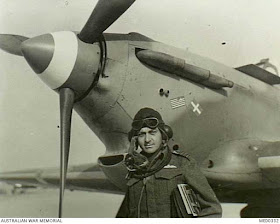 |
| "Western Desert, Libya. 4 February 1942. The colors of the Royal Hellenic Air Force embellish the propeller boss of one of the fighter aircraft of a Squadron operating in the Middle East. 'It is the only view the enemy will get of us' says this determined pilot." Australian War Memorial MED0332. |
During the early morning hours, Doorman's fleet (which is coming from different ports) assembles off the northeast tip of Java. Around 10:00, Doorman sails for the Makassar Strait, where air patrols report seeing the invasion force. The Japanese send bombers against the fleet, badly damaging Marblehead, killing 15 of its crew, and leaving it dead in the water. Houston also is hit and loses 48 men and its rear guns but is still maneuverable. The Japanese also hit De Ruyter but cause only minor damage. After sailing about for a few hours in an unsuccessful search for the Japanese fleet, Doorman finally cancels the operation due to the continuing threat from the bombers. While the Japanese report sinking three cruisers, all of the ABDA ships make it back to port. Because there are no port facilities in the South Pacific large enough to handle Marblehead, it sails for repairs in the United States and is permanently lost to the ABDA Combined Striking Force.
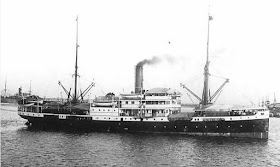 |
| Dutch steamer Van Lansberge (1937grt), sunk after a torpedo attack by IJN I-55 in the Java Sea on 4 February 1942. |
While the Battle of Makassar Strait is inconclusive in some respects, the Japanese are left in control of the Makassar Strait. Thus, it is a major strategic victory for the Japanese as well as being a tactical victory due to the numerous Allied sailors killed and the loss to future operations of one of the ABDA cruisers. The Japanese invasion can proceed and the Allies now begin to lose their grip on the western part of the Dutch East Indies.
 |
| The Evening Leader of 4 February 1942 almost gets it right - but the reality is that Japanese guns are shelling British troops in Singapore, too. |
On Singapore Island, the Japanese shelling and bombing become so bad that the British abandon Tengah Airfield. In truth, this is not a major loss because there are few airplanes left in Singapore anyway. The Japanese issue a formal demand for surrender which the British summarily refuse. British Lieutenant-General Arthur Ernest Percival, who expects an attack in the northeast sector because that's where the causeway is, orders his Australian defenders in the northwest area of the island to go to the edge of the waterway. The defenders there are separated by the Kranji River and cannot support each other when positioned so far forward. The soldiers also are spread thin by covering a very long (11 mile, or 18 km) coastline. The Australians plan to send patrols over the Singapore Strait at night to Johor to gather intelligence on the gathering Japanese forces.
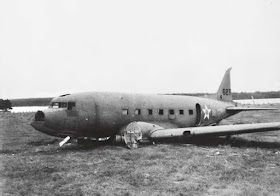 |
| A Douglas C-53B-DO, #41-20051 (C-47), of the 21st Troop Carrier Squadron, USAAF. During a flight from Java to Darwin on 4 February 1942, bad weather forces it to divert to an emergency airfield for light aircraft on Bathurst Island (60 miles north of Darwin). The plane cannot be moved and ultimately is destroyed in a Japanese air raid on 19 February 1942 before it can be repaired and removed. This picture was taken after the air raid that destroyed it. Australian War Memorial AWM Accession No. 152203. Note that the caption on the AWM page is inaccurate. |
In the Philippines, the Allies continue trying to reduce several Japanese pockets behind the Main Line of Resistance (MLR). While the Japanese continue to hold out, they are under increasing pressure. Commanding Lt. Gen. Masaharu Homma continues his sputtering offensive against the strong MLR but is growing increasingly concerned about his trapped men.
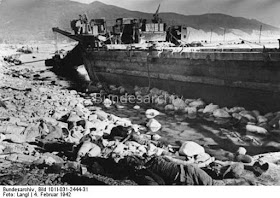 |
| “Soviet Union, Kuban, Osereika Bay near Novorossiysk -- defeated Russian landing attempt in Osereika Bay, with a stranded special Soviet ship for the unloading of tanks, and in the foreground, soldiers lost in battle, 4 February 1942." (Langl, Federal Archive Bild 101I-031-2444-31). |
Eastern Front: The Wehrmacht continues its painful attempt to restore its front, or at least communications to its most isolated units, on 4 February 1942. The
Rollbahn between Yukhnov and Gzhatsk has been cleared, restoring access to the Fourth Army, but many other large units remain blocked from receiving supplies. In the most important movement today, Ninth Army's 46th Panzer Corps advances through blizzards from Sychevka toward Rzhev in order to establish another line of communications to the Fourth Army. If it succeeds in this 30-mile advance, it will create a line in the northwest that will trap large Soviet forces west of the
Rollbahn in its own pocket. The Germans optimistically hope to confine and eliminate Soviet 39th Army in this area southeast of Rzhev, but the German hold is weak everywhere and a focused Red Army effort in virtually any direction would at the very least enable the Soviet troops to break out. However, the Stavka is not interested in breakouts at this time and the Red Army local commanders hold a large swathe of territory in which they receive air supply and also supplies through the porous front. It is a peculiar situation in which both sides consider themselves, with some justification, to be on the offensive, only operating in different directions.
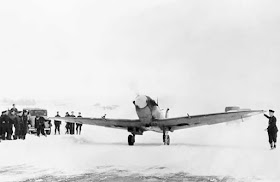 |
| Supermarine Spitfire of No. 603 Squadron RAF taxiing out at Dyce, Scotland, for a routine convoy patrol. 4 February 1942. © IWM (CH 4838). |
European Air Operations: The mid-winter lull in operations continues on 4 February 1942. After dark, three RAF Manchester bombers set off on a mission to lay mines in the Frisian Island area but return to base without laying them due to weather conditions.
Luftwaffe planes sink HNLMS patrol boat Deneb off Zuid Broeder in the Doerian Strait, Riouw Archipelago. There are three deaths.
 |
| HNLMS Deneb, sunk in the North Sea in an air raid on 4 February 1942. |
Battle of the Atlantic: U-103 (Kptlt. Werner Winter), on its sixth patrol out of Lorient, torpedoes and sinks 3627-ton Panamanian banana boat San Gil about 50 nautical miles (93 km) southeast of Atlantic City, New Jersey. Two men are killed in the initial engine room explosion, but the remaining 39 crewmen survive and are picked up by USS Nike later in the day. This incident is sometimes recording as having occurred on 3 February 1942. U-103 also torpedoes and sinks 8327-ton US tanker India Arrow in the same general location, but this incident is usually listed as having occurred on 5 February (sources are very undecided on this U-boat's actual dates for some reason).
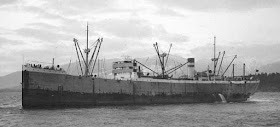 |
| SS Silveray, sunk on 4 February 1942. Photo from City of Vancouver Archives, CVA 447-2695 |
U-751 (Kptlt. Gerhard Bigalk), on its fifth patrol out of St. Nazaire, torpedoes and sinks 4535-ton British freighter Silveray south of Halifax. Silveray is operating as an independent after being dispersed from Convoy ON-55. There are 41 survivors, including the master, and 8 deaths.
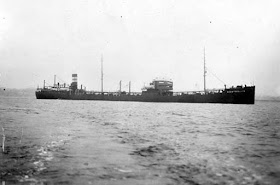 |
| Canadian 11,309-ton tanker MV Montrolite, stalked by U-109 on 4 February 1942 and later sunk. |
U-109 (Kptlt. Heinrich Bleichrodt), on its fourth patrol out of Lorient, torpedoes and sinks 11,309-ton Canadian tanker MV Montrolite northeast of Bermuda. This attack is sometimes given as happening on 5 February, but U-109 begins stalking Montrolite at 21:22 on 4 February 1942. The actual sinking takes place at 02:37 on 5 February. There are 20 survivors and 28 deaths.
HMS Beverley (H-64), formerly USS Branch (DD-197), which was transferred to the Royal Navy on 8 October 1940, sinks U-187 (Oblt. Ralph Münnich) east of Newfoundland. There are 45 survivors and nine dead. U-187, operating with Wolfpack Pfeil on the North Atlantic convoy route is lost on its first patrol and sinks or damages no ships during its career.
 |
| "Western Desert, North Africa. 4 February 1942. Greek pilots of a Royal Hellenic Air Force Squadron receive final instruction upon the course they will fly to their forward landing ground in Libya." Australian War Memorial MED0333. |
Battle of the Mediterranean: Following a British withdrawal on orders of the commander of British Eighth Army, General Ritchie, German Lieutenant General Erwin Rommel's Afrika Korps takes Derna. This solidifies the gains of Rommel's latest offensive beyond Benghazi and provides a foundation for a future advance on Tobruk. Rommel now contemplates his options and decides to consolidate his forces. British Eighth Army retreats in good order to the Gazala Line. This begins a lull in operations that lasts for many weeks.
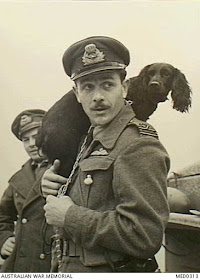 |
| "Western Desert, North Africa. 4 February 1942. This Greek flight commander made a 10-pound wager that he will bring down the first Hun for the Royal Hellenic Air Force. Previously flying night bombers and before that navy co-operation aircraft he is off to the battle zone with his dog on his shoulder." Australian War Memorial MED0313. |
War Crimes: Following the surrender of Australian troops on Ambon Island in the Netherlands East Indies, the "Carnage at Laha" begins. This incident, also known as the Laha Massacre due to its taking place close to the town of Laha, leads to the deaths of perhaps 100 Australian POWs, including commanders. Some Australian POWs, who surrendered under a traditional white flag and after extended negotiations, are kept at prison camps for several days before being executed. The men are executed in traditional Japanese style, blindfolded and beheaded with Samurai swords. Those POWs not executed in this fashion are exterminated through mistreatment over the next two weeks. The Carnage at Laha leads to war crimes prosecutions after the war.
 |
| Harald Gelhaus, commander of U-107. U-107 arrives off the coast of Cape Hatteras, United States, on 4 February 1942 during Operation Paukenschlag. The U-boat has headed south from the New England area, where pickings were slim. |
British/Egyptian Relations: It is no secret that King Farouk has Axis sympathies. The British are concerned because he recently dismissed his entire Cabinet over disagreements about supporting the Allied war effort. British Ambassador to Egypt Sir Miles Lampson decides today to focus King Farouk's attention and create a sense of urgency by surrounding the royal palace with tanks.
US Military: The USAAF Far East Air Force (FEAF) begins transferring bombers of the 7th Bombardment Group, 9th Bombardment Squadron, and 88th Reconnaissance Squadron to Karachi, India. This implicitly is a vote of non-confidence in Australian defenses and a recognition of the growing danger in Burma.
 |
| "Western Desert, North Africa. 4 February 1942. Airborne with its Greek pilot at the controls this Hawker Hurricane fighter aircraft of the Royal Hellenic Air Force sets forth to a Libyan landing ground." Australian War Memorial MED0334. |
British Government: Lord Beaverbrook (Max Aitken) becomes Britain's Minister of Production. This is a newly created position that places Beaverbrook in contact with Ernest Bevin, Minister of Labour and National Services. The two men have a history of not getting along, and Bevin now refuses to work with Beaverbrook despite the latter's previous successes as Minister of Aircraft Production. This conflict will come to a head within two weeks.
American Homefront: The US Department of Justice under Attorney General Francis Biddle orders all enemy (Japanese, German, and Italian) aliens to leave 31 vulnerable sectors in the states of Oregon and Washington by 15 February 1942.
Major General Joseph Henry Pendleton (June 2, 1860 – February 4, 1942) passes away in Coronado, California. Following a 40-year career in the US Marine Corps, he served as mayor of Coronado from 1928-1930. Marine Corps Base Camp Pendleton in San Diego County is named in his honor.
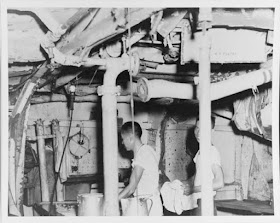 |
| USS Marblehead (CL-12): "In Netherlands East Indies, Tjilatjap, Java, after being damaged by Japanese air attack during the Battle of Java Sea, on 4 February 1942. Chinese cooks at work in the cruiser's bomb-wrecked wardroom pantry." Naval History and Heritage Command Catalog #: 80-G-237444. |
February 1942
February 1, 1942: The US Navy Strikes Back
February 2, 1942: Germans Recovering in Russia
February 3, 1942: Japanese Shell and Bomb Singapore
February 4, 1942: Battle of Makassar Strait
February 5, 1942: Empress of Asia Sunk
February 6, 1942: The Christmas Island Body
February 7, 1942: The Double-V Campaign
February 8, 1942: Japan Invades Singapore
February 9, 1942: French Liner Normandie Capsizes
February 10, 1942: US Car Production Ends
February 11, 1942: Tomforce Fails on Singapore
February 12, 1942: The Channel Dash
February 13, 1942: Japanese Paratroopers In Action
February 14, 1942: RAF Orders Terror Raids
February 15, 1942: Japan Takes Singapore
February 17, 1942: Indian Troops Defect to Japanese
February 18, 1942: Battle of Badung Strait
February 19, 1942: FDR Authorizes Internment Camps
February 20, 1942: O'Hare the Hero
February 21, 1942: Crisis in Burma
February 22, 1942: Bomber Harris Takes Over
February 23, 1942: Bombardment of Ellwood, California
February 24, 1942: US Raid on Wake Island
February 25, 1942: Battle of Los Angeles
February 26, 1942: Gneisenau Eliminated
February 27, 1942: Battle of Java Sea
February 28, 1942: Battle of Sunda Strait
2020















No comments:
Post a Comment